
The zebra mussel is a small freshwater mussel. The species was originally native to the lakes of southern Russia and Ukraine, but has been accidentally introduced to numerous other areas and has become an invasive species in many countries worldwide. Since the 1980s, the species has invaded the Great Lakes, Hudson River, and Lake Travis.

Dreissena is a genus of small freshwater mussels in the family Dreissenidae. The exact taxonomy of the species within the genus Dreissena is, however, uncertain.

The ʻanianiau is a species of Hawaiian honeycreeper that is endemic to upper elevation forests on the island of Kauai.
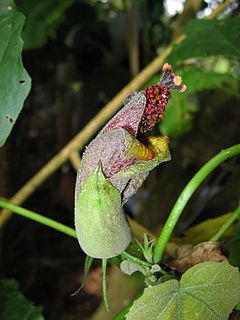
Hibiscadelphus giffardianus is a species of flowering plant in the mallow family, Malvaceae, that is endemic to the Big Island of Hawaii. It is believed to be extinct in the wild; any remaining plants are threatened by habitat loss. Cultivated plants exist in Hawaii Volcanoes National Park. It inhabits mixed mesic forests on the slopes of Mauna Loa at elevations of 1,200–1,310 m (3,940–4,300 ft). Associated plants include ʻōhiʻa lehua, koa, mānele, hoio, pilo, māmaki, kōpiko, olopua, alani, ʻaʻaliʻi, and naio. H. giffardianus is a small tree, reaching a height of 7 m (23 ft) and trunk diameter of 30 cm (12 in).
Kokia kauaiensis, the Kauai treecotton or Kauaʻi Kokiʻo, is a species of flowering plant in the mallow family, Malvaceae, that is endemic to Kauaʻi, Hawaii.

Discula is a genus of small land snails, terrestrial pulmonate gastropod mollusks in the family Geomitridae, the hairy snails and their allies.
Melanoides polymorpha is a species of freshwater snail with a gill and an operculum, an aquatic gastropod mollusk in the family Thiaridae.
Pseudopalaina polymorpha is a species of small land snail with an operculum, a terrestrial gastropod mollusk in the family Diplommatinidae. This species is endemic to Palau.
This is a list of plants which includes trees and other herbs, vines, climbers, lianas, shrubs, subshrubs that are native or endemic, found in Cuba.

Amyris is a genus of flowering plants in the citrus family, Rutaceae. The generic name is derived from the Greek word αμυρων (amyron), which means "intensely scented" and refers to the strong odor of the resin. Members of the genus are commonly known as Torchwoods because of their highly flammable wood.
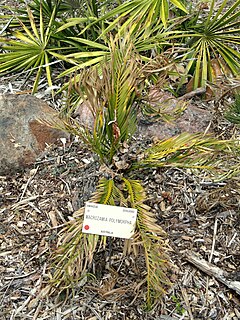
Macrozamia polymorpha is a species of plant in the family Zamiaceae. It is endemic to New South Wales, Australia.
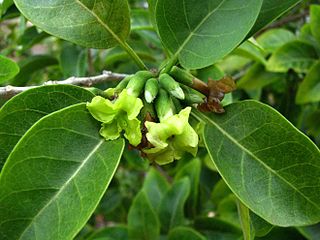
Nothocestrum breviflorum, commonly known as smallflower ʻaiea, is a species of tree in the nightshade family, Solanaceae, that is endemic to the island of Hawaiʻi. It inhabits dry and mixed mesic forests at elevations of 180–1,830 m (590–6,000 ft). These forests are dominated by ʻōhiʻa lehua and koa or lama, while plants associated with smallflower ʻaiea include wiliwili and uhiuhi. N. breviflorum reaches a height of 10–12 m (33–39 ft). It is threatened by habitat loss. It is federally listed as an endangered species of the United States. There are fewer than 50 individuals remaining.
Dracaena konaensis, synonym Pleomele hawaiiensis, the Hawaiʻi hala pepe, is a rare species of flowering plant that is endemic to the island of Hawaiʻi in the state of Hawaii.
Tabebuia polymorpha is a species of plant in the family Bignoniaceae. It is endemic to Cuba. It is threatened by habitat loss.

Xylosma crenata, the sawtooth logwood, is a species of flowering plant in the willow family, Salicaceae, that is endemic to the island of Kauaʻi in Hawaii. It is a tree, reaching a height of 46 ft (14 m). Sawtooth logwood inhabits montane mesic forests dominated by koa and ʻōhiʻa lehua at elevations of 975–1,065 m (3,199–3,494 ft). It is threatened by habitat loss.
Zamia polymorpha is a species of plant in the family Zamiaceae. It is found in Belize and Mexico. It is threatened by habitat loss.
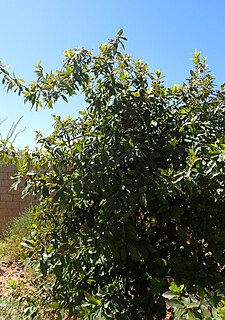
Quercus polymorpha, the Mexican white oak, Monterrey oak or netleaf white oak, is a North American species of oak. It is widespread in Mexico, Guatemala, and Honduras, and known from a single population in the United States but widely planted as an ornamental.

The Hawaiʻi ʻelepaio, also Hawaiian ʻelepaio, is a monarch flycatcher found on the Big Island of Hawaii. Until 2010, all three ʻelepaio species, the Kauaʻi ʻelepaio, the Oʻahu ʻelepaio and this species were considered conspecific.
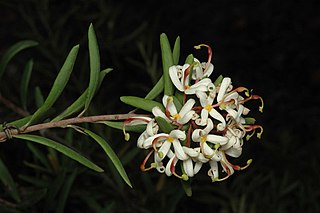
Lomatia polymorpha, commonly known as mountain guitar plant, is a shrub or small tree of the family Proteaceae which is endemic to Tasmania. It is a shrub or small tree with linear leaves, and white, cream-coloured or greenish flowers. It is common throughout its range which is approximately complementary to that of L. tinctoria in Tasmania.
A. polymorpha may refer to:












